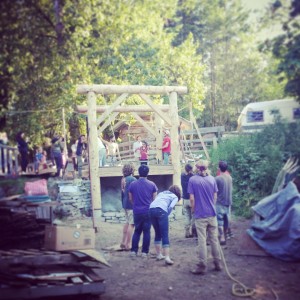Permaculture (permanent agriculture) is based on natural systems that integrates human activity with our surroundings. It is a method of feeding the human population with the least amount of energy and waste byproduct. This is becoming increasingly important as the Haber-Bosch Process, which relies on fossil fuels is becoming evermore unsustainable.
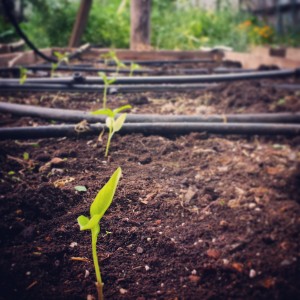
Pepper seedlings planted in compost soil, without the aid of synthetic fertilizers
While a majority of the air we breath is nitrogen (N2), the nitrogen needs to be a part of soil (fixed nitrogen) in order for plants to use it. The Haber-Bosch Process is a complex chemical procedure that takes nitrogen from the air and under high pressures and temperatures combines it with hydrogen (fossil fuels) to produce ammonia. This ammonia is the base of the synthetic nitrogen fertilizers increasingly used around the world today.
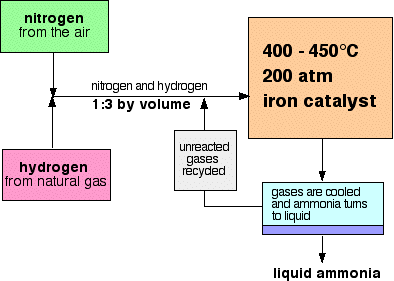
Nearly one century after its invention, the process is still applied all over the world to produce 500 million tons of artificial fertilizer per year. 1% of the world’s energy supply is used for it (Science 297(1654), Sep 2002); it still sustains roughly 40% of the population (M. D. Fryzuk, Nature 427, p 498, 5 Feb 2004). Billions of people would not even exist without it. And our dependence will only increase as the global count moves from six to ten billion people or so.
While the Haber-Bosch Process is responsible for sustaining our population, its negative consequences are:
- Serious imbalances to the nitrogen cycle.
- High fossil fuel energy inputs.
- Negative effects on soil organisms and soil organic matter.
- Excess runoff cause ocean dead zones.
- Major component of weapons including all those roadside bombs.

Clovers are nitrogen fixing plants, they are a sustainable alternative to lawns
Before the Haber-Bosch Process, enzymes called Nitrogenases are used by some organisms to fix atmospheric nitrogen gas (N2). There are specific plants that allow for these Nitrogenases to fix nitrogen into the soil. Traditionally, farmers would rotate crops through the field, ensuring a nitrogen fixing plant would replenish the soil with nitrogen before the next crop was planted. In industrialized farming however, a field may have the same crop for many years, with fertilizers added to enrich the soil.

Permaculture was pioneered by Bill Mollison, an Australian horticulturist who turned to nature to find methods of creating a permanent agriculture, where we do not have to pour so much energy into food production. Did you ever wonder how there are forests are able to exist for hundreds of years without any regulation or additives, but we have to annually fertilize our agriculture land or else it becomes barren? Permaculture values caring for the Earth, caring for people, and a return of excess product back into the cycle.
There are twelve design principles by David Holmgren (1979) to provide an outline for how to create permaculture. It is recommended to focus on two or three principles at a time, and revolve through them as they are necessary:
1. Observation – Use thoughtful observation of natural systems rather than thoughtless use of labor. Observe- what are natural systems doing? (whom is eating whom and which way does the water want to flow?) What are the natural patterns? Form informs function. Patterns reveal stories, relationships, actual and potential energies. Observe a place for at least a one year cycle before making any major changes. Permaculture itself is a cyclic pattern: Observe, map, design, implement, observe, map, design, map, implement, observe….
2. Relative Location – Every element is placed in working relationship to another, so that they can assist each other’s needs and energy is efficiently used. Maximize relationships among components. ie: what is the logical location for ponds, trees, plants, animals, and compost in relationship with each other? Design with access in mind. Identify Zones (human use) for most to least use, and Sectors (outside factors) for sun, wind, fire, flood, wildlife.
3. Every Element Supports Multiple Functions (Stacking Functions) – Place each element (plant, animal, water, structure) so that it serves at least 2 or more functions. ie: a pond provides cooling, supports ducks, fish and aquatic plants, creating habitat; catches rainfall and stores water for irrigation, provides fire protection or drinking water; the clay dug from the pond can be used for natural building. A plant/tree may supply food, mulch, privacy, windbreak, fuel, erosion control, habitat, soil amendments, climate regulation.
4. Every Function Is Supported By Many Elements (Planned Redundancy) – Ensure that each important function (water, food, energy, income) will be met despite the failure of one or more elements. ie: polyculture crops, diverse energy sources, diverse fresh water source, diverse livelihoods.
5. Onsite & Biological Resources – Onsite – Determine what resources are available, and what nature provides, and what resources are entering into the system on their own, and maximize their use, rather than outside resources and fossil fuels. Biological Resources: Utilize biological intelligence (who is naturally doing what) in order to aid in fertility and maintenance of the land, thus decreasing the human and technological workload: ie: beneficial insects for pest management; fertilizer from compost, animal and green manure; methane gas from animals for energy; pollination from birds and insects; chickens for soil tilling; mushrooms for decomposition; goats for weed control. Utilize the help of bees, birds, worms, bacteria, fungus, ducks, chickens, horses, cows, spiders, frogs, bats etc. (“what we call resources, native peoples call relatives.” Penny Livingston)
6. Energy & Waste Recycling – The Energy needs of a system should be found, caught, stored and used (and not wasted) on-site (or locally) and waste should be recycled on-site. In nature, there is no such thing as “waste”. Pollution is an unused resource. Energy comes from sun, wind, water, animals, people and wastes. Capture, use and recycle energy many times before it leaves the system. Turn sunlight into plants, plants into food for animals, animals into manure, meat, compost, heat and other animals. Use water many times before replenishing the earth. Also, do not produce more carbon than can be reabsorbed by the system. Grow cover crops to replace the minerals and nutrients exported during the harvest. Give back what you consume: grow soil, replace minerals compost organic material, plant trees and vegetation that provide food and habitat. Maintain a regenerative cycle.
7. Appropriate Technology – (It Depends!) – Often appropriate technology is “low tech” instead of high tech (you can build and maintain it yourself). What may be appropriate in one location or bioregion may not be in another. What is the appropriate solution for the situation-what are your particular needs, material and financial resources, or abilities? Technology applies to energy efficiency, cooking, lighting, heating, transportation, farming, building, food, water and waste
collection and processing, and other energy needs.
8. Natural Succession – Time is nature’s way of keeping everything from happening at once. Recognize that certain elements prepare the way for the system to support other elements in the future. ie: prepare the soil by mulching weeds or planting a cover crop. Pioneer plants such as dock indicate the type of soil and prepare it for other plants to evolve the ecosystem. A pond dries up and becomes a meadow. Design for succession. Systems are dynamic, not static.
9. Maximize Edge – Optimize edges. The edge is where the action is! Edges or eco-tones are the interfaces where two ecosystems come together to form a third, and more diverse, fertile and productive area, because energies and materials
accumulate there and resources from both ecosystems can be used. Edges of ponds, forests, meadows, fences, hedges and natural borders are habitat for plants, animals, insects and microorganisms. Curved lines create more gardening space for planting than straight ones.
10. Diversity – Nature is complex and dynamic. As ecosystems mature, they become increasingly diverse over time. The number of elements is not as important as the functioning connections between them. Diversity is the result of the balance and tension in nature between variety and possibility working harmoniously together. The diversity of growing polyculture crops provides stability and resilience against pests and diseases.
11. Work With Nature Rather Than Against It – Aiding in natural cycles results higher yields and less work. Plant what will grow in your planting hardiness zone, climate and ecosystem. Don’t grow water intensive crops in the desert. Don’t
build on a floodplain. Use slopes/gravity to your advantage. Build at an existing degraded site, rather than cutting down a healthy forest. Cooperation rather than competition. Mimic nature (biomimicry).
12. The Problem Is The Solution – We are the problem, and we are the Solution. Focus on opportunity rather than obstacle to turn constraints into resources. How can we use a ‘problem’ to our advantage? There are no “problems” in nature. In native languages, there is no word for weeds or pests. A high wind may be a solution for catching energy. If you have slugs in your garden, and you are out of chicken feed, you don’t have a slug problem in your garden; you have a chicken deficiency. The only limit on the number of uses of a resource is the limit of the information and the imagination of the designer.
For a great local resource, visit www.villagevancouver.ca
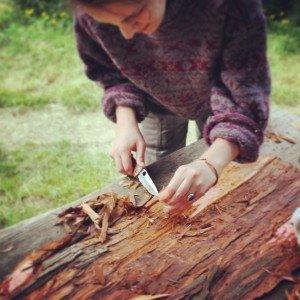 This spring I was involved in a three week Community Field Experience at O.U.R. Ecovillage. The Ecovillage is a demonstration site that focuses on permaculture and natural building methods. The Ecovillage welcomes all learners whether they are in kindergarten, or a PhD program, or a member of the general public who wishes to know more.
This spring I was involved in a three week Community Field Experience at O.U.R. Ecovillage. The Ecovillage is a demonstration site that focuses on permaculture and natural building methods. The Ecovillage welcomes all learners whether they are in kindergarten, or a PhD program, or a member of the general public who wishes to know more. 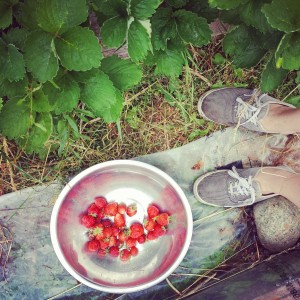 My time was divided into teaching, lesson planning, and participating in the building and permaculture activities. My particular interest was in the gardens and green houses where I learnt about methods of growing, harvesting, and tending to both annuals and perennials. I hope to incorporate my new found love into my role as an educator in the future.
My time was divided into teaching, lesson planning, and participating in the building and permaculture activities. My particular interest was in the gardens and green houses where I learnt about methods of growing, harvesting, and tending to both annuals and perennials. I hope to incorporate my new found love into my role as an educator in the future.
